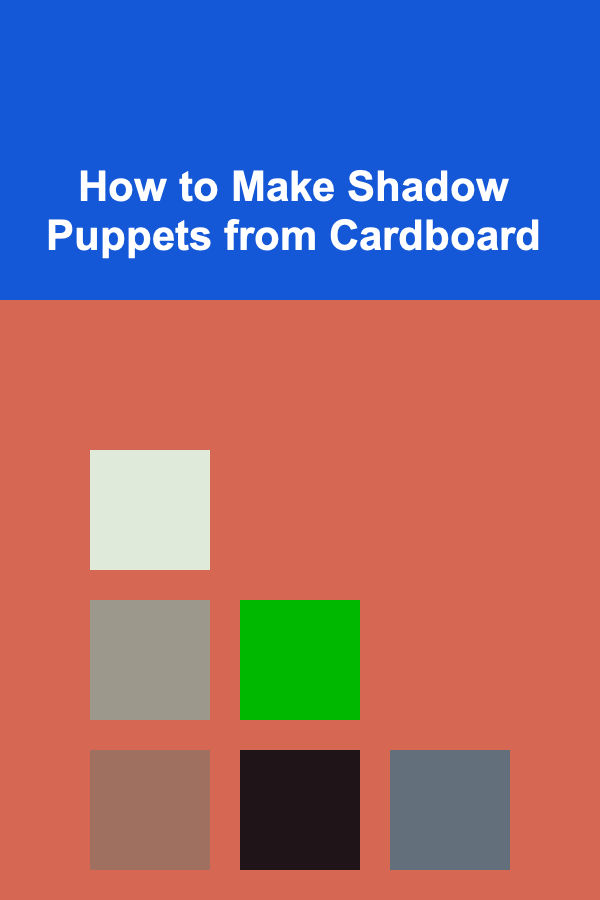
How to Make Shadow Puppets from Cardboard
ebook include PDF & Audio bundle (Micro Guide)
$12.99$11.99
Limited Time Offer! Order within the next:

Shadow puppetry is one of the oldest forms of theatre, tracing back thousands of years to ancient China, Indonesia, and India. This art form has captivated audiences for centuries with its enchanting illusions and evocative storytelling. While shadow puppetry traditionally requires intricate craftsmanship and skill, you can easily create your own shadow puppets at home using materials as simple as cardboard. This guide will take you through the steps of making shadow puppets from cardboard, whether for a fun project, a school assignment, or to entertain family and friends.
Understanding Shadow Puppets
Shadow puppets are flat, articulated figures that are held between a light source and a screen to cast a shadow. The light creates a sharp silhouette, and the shadow plays a crucial role in storytelling. These figures can be simple or highly detailed, depending on the artist's preferences and the complexity of the performance. In traditional shadow puppetry, puppeteers move the figures behind a screen, creating motion and depth through subtle manipulations.
Benefits of Making Cardboard Shadow Puppets
- Accessible Materials: Cardboard is inexpensive and easy to obtain, making it an ideal material for beginners.
- Creative Expression: Shadow puppetry allows for limitless creativity, whether you choose to create animals, characters, or abstract forms.
- Educational: This project offers an opportunity to explore the principles of light and shadow, as well as the art of visual storytelling.
- Family Fun: It's an excellent project for families or groups, fostering collaboration and creativity among participants.
Now that you understand the basics, let's get started on creating your own shadow puppets from cardboard.
Materials You'll Need
To create your own shadow puppets, gather the following materials:
- Cardboard: Use lightweight cardboard for easy handling. You can recycle old boxes or use craft cardboard from a local store.
- Scissors or Craft Knife: For cutting out the shapes of your puppets. A craft knife will allow for more precision, but scissors work well for larger shapes.
- Pencil or Pen: For sketching the design of your puppets before cutting.
- Ruler: To help measure and draw straight lines for accurate shapes.
- Glue: Strong adhesive such as hot glue or craft glue to attach various parts of the puppet or handle.
- Brads or Fasteners: If your puppet design requires articulation (e.g., movable joints), these are essential for connecting parts together.
- Wooden Dowels or Straws: These will serve as handles for your puppets.
- A Light Source: A flashlight, desk lamp, or any other focused light source to cast shadows.
- Screen: A white sheet, piece of parchment paper, or a stretched fabric can serve as the backdrop for your performance.
Optional Materials
- Paint or Markers: To add detail or color to your puppets (though traditional shadow puppets are usually monochromatic).
- Tracing Paper: For finer details and more delicate designs.
- Fabric: If you want to add texture or clothing to your puppets, fabric pieces can enhance your design.
Step 1: Sketch Your Puppet Design
The first step in making your shadow puppet is to decide on the design. Shadow puppets can be anything you imagine---people, animals, objects, or even abstract shapes. Keep in mind that shadow puppets are meant to create recognizable silhouettes, so focus on clear shapes with strong outlines.
- Choose Your Character: Think about the type of character you want to create. For example, if you're creating an animal, you might want to choose a simple shape like a rabbit, bird, or cat.
- Create Simple, Bold Shapes: Sketch the basic outline of the puppet. Avoid unnecessary details, as too many fine details can be lost in the shadow. For instance, if you're creating a person, you might want to include arms, legs, and the head, but leave out intricate facial features.
- Consider Movement: If you want your puppet to be dynamic, think about how it can move. You may need to design multiple parts that can be articulated (such as the arms and legs of a character).
- Trace Over Your Sketch: Once you're happy with your design, go over it with a pen or dark pencil to make it easier to cut out.
Step 2: Transfer the Design to Cardboard
Once you've sketched your design, the next step is to transfer it to the cardboard.
- Choose a Flat Piece of Cardboard: Pick a piece of lightweight cardboard that's large enough to fit your puppet design. If your design is too large, consider splitting it into parts that can be assembled later.
- Trace the Design: Lay your sketch on the cardboard, and carefully trace around the edges of your puppet with a pencil or pen.
- Outline Key Features: You can add extra features to your design now, like details for eyes, ears, or accessories. However, remember that the features should still be simple enough to create a strong silhouette.
Step 3: Cut Out the Puppet Shape
Now it's time to bring your puppet to life by cutting it out of the cardboard.
- Cut with Precision: Use sharp scissors or a craft knife to carefully cut out the shape of your puppet. Take your time to ensure clean, smooth edges. If you're using a craft knife, make sure to work on a cutting mat or another protective surface.
- Cut Any Small Details: If your design includes small elements like eyes, fingers, or clothes, use your craft knife to cut out those details. Remember that the smaller the detail, the less visible it will be in the shadow, so keep it simple.
Step 4: Add Articulation (Optional)
If you want your puppet to move, you'll need to create articulated joints. This is where you'll attach different parts of the puppet (like the arms, legs, or wings) in a way that allows them to move independently.
- Plan Your Joints: Identify where your puppet needs to move. Typically, joints are placed at elbows, shoulders, knees, and wrists.
- Use Brads or Fasteners: To attach the puppet's limbs or other movable parts, use brads (also called split pins) or small fasteners. These allow you to connect the parts while still enabling them to rotate.
- Drill Holes for the Joints: Use a small hole punch or craft knife to create tiny holes at the connection points of your puppet. Make sure the holes are aligned so the limbs can move easily.
- Attach the Parts: Insert the brads through the holes and secure the limbs, making sure they are able to move smoothly.
Step 5: Attach a Handle
Now that your puppet is cut out and articulated (if desired), it's time to add a handle. This will allow you to manipulate the puppet during the performance.
- Choose a Handle: Use a wooden dowel, plastic straw, or any other sturdy object to create the handle.
- Glue the Handle: Attach the handle to the bottom of the puppet with strong glue (hot glue or craft glue works well). Make sure the handle is secure and positioned in a way that allows you to move the puppet easily.
- Reinforce if Necessary: If the handle seems flimsy or the puppet is heavy, you can reinforce the connection with additional layers of glue or tape.
Step 6: Prepare the Shadow Screen
Your puppet is almost ready to perform! The next step is to set up the shadow screen. This is where the magic of shadow puppetry happens, as the light from behind will cast the shadow of the puppet onto the screen.
- Set Up a Light Source: Choose a focused light source such as a desk lamp, flashlight, or even a phone's flashlight. Position it behind the puppet screen.
- Create the Screen: You can use a white sheet, parchment paper, or stretched fabric as the screen. It should be semi-translucent, so the light can pass through but still cast clear shadows.
- Mount the Screen: Hang or stretch the material in a way that it remains taut and stable, either on a frame or between two objects.
Step 7: Experiment and Perform
Now comes the fun part---performing with your cardboard shadow puppet!
- Test Your Shadows: Hold the puppet in front of the light source and experiment with different movements. Observe how the shadow changes with the angle and distance from the light.
- Adjust the Puppeteer's Position: You may need to adjust your position to create the desired shadow effect. Shadows may appear sharper or more blurry depending on how close or far the puppet is from the light.
- Storytelling: Once you're comfortable with the movement, start telling a story! Use multiple puppets, sound effects, and different lighting to enhance the drama. You can also add voices or music to create a full shadow puppet performance.
Conclusion
Making shadow puppets from cardboard is a fun and educational project that allows you to explore the magic of light, shadow, and storytelling. By following these steps, you can create simple, yet captivating, puppets that can entertain and inspire audiences of all ages. Whether you use your puppets for a personal performance or as part of a larger production, shadow puppetry offers a unique way to connect with others through creativity and imagination.
As you experiment with your creations, you'll discover endless possibilities in the world of shadow puppetry. Happy crafting, and may your shadows tell great stories!
Reading More From Our Other Websites
- [Home Soundproofing 101] How to Soundproof Windows Without Replacing Them
- [Home Family Activity 101] How to Make Your Own Family Board Game from Scratch
- [Organization Tip 101] How to Create a Functional and Tidy Home Bar Area
- [Horseback Riding Tip 101] Beyond the Trail: A Guide to the Best Horse-Riding Activities and Experiences on Vacation
- [Home Pet Care 101] How to Protect Your Pet from Seasonal Allergies
- [Home Space Saving 101] How to Organize Cables and Cords: A Space-Saving Guide for a Clutter-Free Life
- [Polymer Clay Modeling Tip 101] Eco-Friendly Polymer Clay Beads: Sustainable Materials and Creative Ideas
- [Home Staging 101] How to Plan a Budget for Staging Cost Per Room Without Overspending
- [Rock Climbing Tip 101] Best Strategies for Managing Sleep Deprivation on Multi‑Day Aid Climbs
- [Personal Financial Planning 101] How to Save for a Down Payment Quickly: Proven Strategies for Homeownership

How To Discover Award-Winning Novels of All Time
Read More
How to Make Your Home Feel Cozy with Budget-Friendly Decor
Read More
How to Write a Speech for Any Occasion
Read More
Minimizing Food Waste: Simple Steps for a More Sustainable Lifestyle
Read More
How To Master the Neuroscience of Empathy
Read More
Understanding Route-Building Board Games: A Deep Dive
Read MoreOther Products

How To Discover Award-Winning Novels of All Time
Read More
How to Make Your Home Feel Cozy with Budget-Friendly Decor
Read More
How to Write a Speech for Any Occasion
Read More
Minimizing Food Waste: Simple Steps for a More Sustainable Lifestyle
Read More
How To Master the Neuroscience of Empathy
Read More